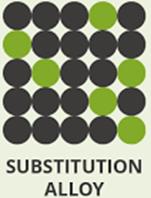
Concept explainers
Interpretation:
The reason for zinc and copper to be used as substitutional and not interstitial alloy needs to be explained.
Concept introduction:
When there is combination of metals or metals that are combined with one or more elements then we get alloy. The elements like gold, silver, iron, non metallic carbon, combined with other elements to give alloys. Alloys have properties which have increased strength and hardness, corrosion resistance, and have good mechanical strength. It is used in buildings, tools, automobiles, etc.
Answer to Problem 92A
Copper and zinc have the same size and therefore will substitute certain empty spaces and cannot form interstitial alloys as it cannot get into the spaces between the lattice points
Explanation of Solution
There is two mechanism when molten metal is mixed with another substance, namely exchange of atoms or interstitial mechanism. Depending on the size of the atom, the mechanism will be utilized.
The exchange of atom happens when the atoms are of similar size and substitution of atoms in metallic crystals, it is substitutional alloy.
The size of copper and zinc ions are similar. Hence, it can replace each other forming substitutional alloy.

Example is Brass and Bronze.
But the copper and zinc will not form interstitial alloy as the size of the atoms are such that it will not fit it self in between the interstitial space.
Copper and zinc have the same size and therefore will substitute certain empty spaces and cannot form interstitial alloys as it cannot get into the spaces between the lattice points
Chapter 7 Solutions
Chemistry: Matter and Change
Additional Science Textbook Solutions
Essential Organic Chemistry (3rd Edition)
Chemistry: The Central Science (14th Edition)
General Chemistry: Principles and Modern Applications (11th Edition)
Chemistry: Structure and Properties
 ChemistryChemistryISBN:9781305957404Author:Steven S. Zumdahl, Susan A. Zumdahl, Donald J. DeCostePublisher:Cengage Learning
ChemistryChemistryISBN:9781305957404Author:Steven S. Zumdahl, Susan A. Zumdahl, Donald J. DeCostePublisher:Cengage Learning ChemistryChemistryISBN:9781259911156Author:Raymond Chang Dr., Jason Overby ProfessorPublisher:McGraw-Hill Education
ChemistryChemistryISBN:9781259911156Author:Raymond Chang Dr., Jason Overby ProfessorPublisher:McGraw-Hill Education Principles of Instrumental AnalysisChemistryISBN:9781305577213Author:Douglas A. Skoog, F. James Holler, Stanley R. CrouchPublisher:Cengage Learning
Principles of Instrumental AnalysisChemistryISBN:9781305577213Author:Douglas A. Skoog, F. James Holler, Stanley R. CrouchPublisher:Cengage Learning Organic ChemistryChemistryISBN:9780078021558Author:Janice Gorzynski Smith Dr.Publisher:McGraw-Hill Education
Organic ChemistryChemistryISBN:9780078021558Author:Janice Gorzynski Smith Dr.Publisher:McGraw-Hill Education Chemistry: Principles and ReactionsChemistryISBN:9781305079373Author:William L. Masterton, Cecile N. HurleyPublisher:Cengage Learning
Chemistry: Principles and ReactionsChemistryISBN:9781305079373Author:William L. Masterton, Cecile N. HurleyPublisher:Cengage Learning Elementary Principles of Chemical Processes, Bind...ChemistryISBN:9781118431221Author:Richard M. Felder, Ronald W. Rousseau, Lisa G. BullardPublisher:WILEY
Elementary Principles of Chemical Processes, Bind...ChemistryISBN:9781118431221Author:Richard M. Felder, Ronald W. Rousseau, Lisa G. BullardPublisher:WILEY





